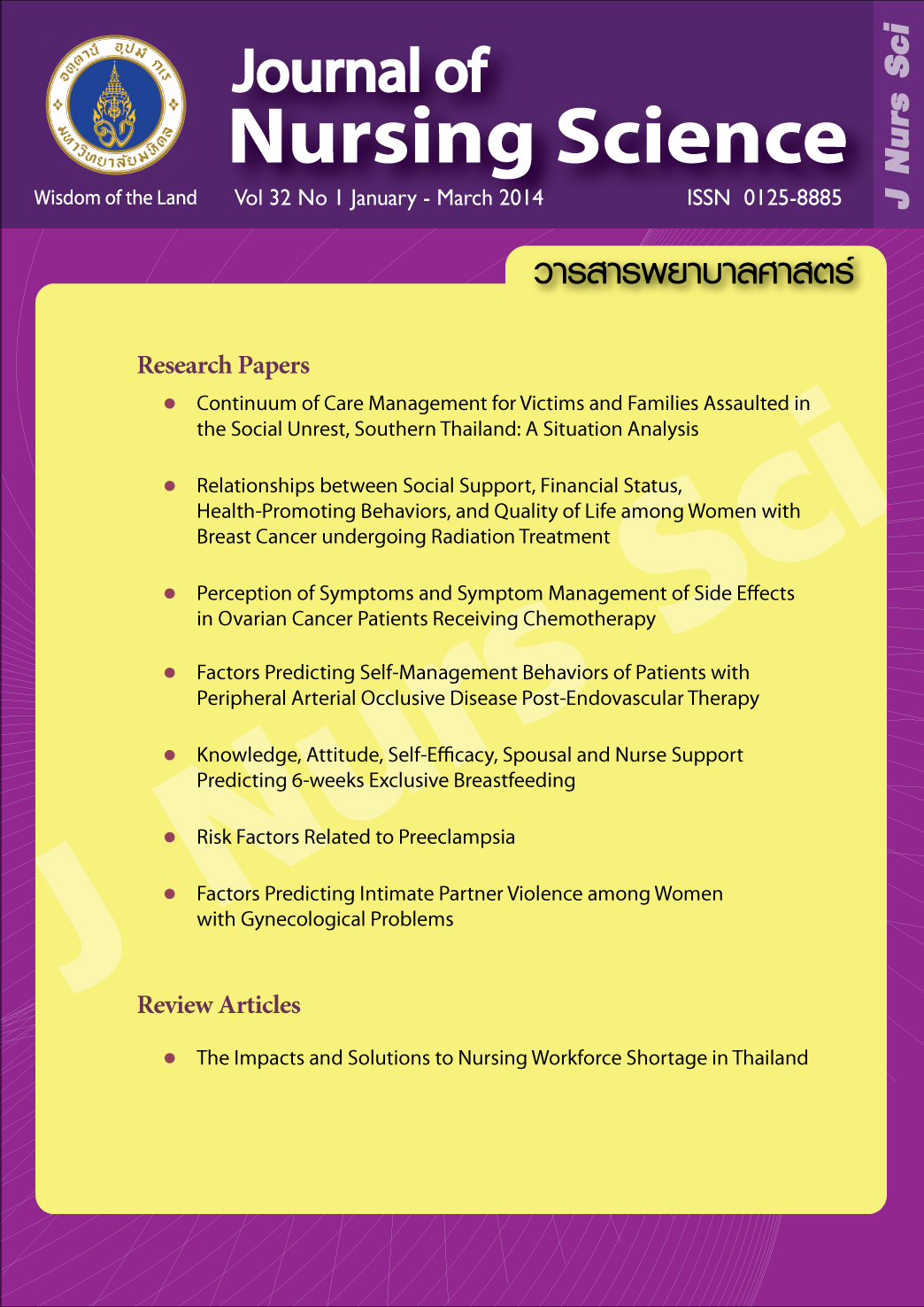Factors Predicting Intimate Partner Violence among Women with Gynecological Problems
Main Article Content
Abstract
Purpose: The purpose of this study was to examine factors (e.g., age, length of marriage, number of marriages, income, age at first sexual intercourse, and number of sexual partners) that can predict intimate partner violence (IPV) among women with gynecological problems.
Design: Predictive correlational design.
Methods: Participants were 532 women with gynecological problems admitted at a university hospital in Bangkok. All participants completed a set of questionnaires, including demographic characteristics, sexual factors, and the Index of Spouse Abuse (ISA) which were then analyzed with descriptive statistics, Pearson’s correlation, and Hierarchical linear regression.
Main findings: IPV was positively correlated with number of marriages and number of sexual partners, whereas it was negatively correlated with income and age at first sexual intercourse. For factors predicting IPV, the result revealed that number of marriages, income, age at first sexual intercourse, and number of sexual partners could jointly explain 12% of the variance in IPV (R2 = .121, p < .01). Number of sexual partners was the most influence predictors of IPV (β = .414, p < .05). Subsequent predictors were age at first sexual intercourse (β = - .126, p < .05) and income (β = - .107, p < .05), respectively.
Conclusion and recommendations: Gynecological nurses should provide appropriate sexual education about avoiding of early sexual intercourse and having multiple partners among all women with gynecological problems, particularly women with multiple sexual partners, early sexual intercourse, and low income. Additionally, screening of IPV should be integrated with the gold standard of gynecological nursing care. Future research should explore the extent to which IPV and these predicting factors are correlated with short-term and long-term women’s sexual health outcomes.
Keywords: abused, intimate partner violence, gynecology, predicting factors, women
ปัจจัยทำนายความรุนแรงที่เกิดจากคู่สมรสในสตรีที่มีปัญหาทางนรีเวช
บทคัดย่อ
วัตถุประสงค์: เพื่อศึกษาปัจจัย (ได้แก่ อายุ ระยะเวลาสมรส จำนวนครั้งของการแต่งงาน รายได้ อายุที่มีเพศสัมพันธ์ครั้งแรก และจำนวนคู่นอน) ที่สามารถทำนายความรุนแรงที่เกิดจากคู่สมรสในสตรีที่มีปัญหาทางนรีเวช
รูปแบบการวิจัย: ความสัมพันธ์เชิงทำนาย (Predictive correlational design)
วิธีดำเนินการวิจัย: กลุ่มตัวอย่างเป็นสตรีที่มีปัญหาทางนรีเวชจำนวน 532 คน ซึ่งเข้ารับการรักษาในโรงพยาบาลมหาวิทยาลัยแห่งหนึ่งในกรุงเทพมหานคร แบบสอบถามประกอบด้วยลักษณะส่วนบุคคล ปัจจัยทางเพศสัมพันธ์ และแบบประเมินความรุนแรงโดยคู่สมรส วิเคราะห์ข้อมูลด้วยสถิติเชิงพรรณนา การหาความสัมพันธ์ของเพียร์สัน และการวิเคราะห์ถดถอยแบบเชิงชั้น
ผลการวิจัย: ความรุนแรงที่เกิดจากคู่สมรสมีความสัมพันธ์ทางบวกกับจำนวนครั้งของการแต่งงานและจำนวนคู่นอนแต่มีความสัมพันธ์ทางลบกับรายได้และอายุที่มีเพศสัมพันธ์ครั้งแรก เมื่อวิเคราะห์ปัจจัยทำนายความรุนแรงที่เกิดจากคู่สมรส สำหรับปัจจัยทำนายความรุนแรงที่เกิดจากคู่สมรส ผลการวิจัยพบว่า จำนวนครั้งของการแต่งงาน รายได้ อายุที่มีเพศสัมพันธ์ครั้งแรก และจำนวนคู่นอนร่วมกันทำนายความรุนแรงได้ร้อยละ 12 (R2 = .121, p < .01) จำนวนคู่นอนเป็นปัจจัยที่มีอำนาจในการทำนายความรุนแรงที่เกิดจากคู่สมรสสูงสุด (β = .414, p < .05) รองลงมาคือ อายุที่มีเพศสัมพันธ์ครั้งแรก (β = - .126, p < .05) และรายได้ (β = - .107, p < .05) ตามลำดับ
สรุปและข้อเสนอแนะ: พยาบาลนรีเวชควรให้ความรู้เรื่องเพศสัมพันธ์ที่เหมาะสมเกี่ยวกับการหลีกเลี่ยงการมีเพศสัมพันธ์ก่อนวัยอันควร และการมีคู่นอนหลายคนแก่สตรีที่มีปัญหาทางนรีเวชทุกราย โดยเฉพาะสตรีที่มีคู่นอนหลายคน สตรีที่มีเพศสัมพันธ์ก่อนวัยอันควร หรือสตรีที่มีรายได้น้อย นอกจากนี้การคัดกรองความรุนแรงที่เกิดจากคู่สมรสควรเป็นส่วนหนึ่งของมาตรฐานในการพยาบาลทางนรีเวช การวิจัยในอนาคตควรมีการศึกษาความสัมพันธ์ระหว่างความรุนแรงที่เกิดจากคู่สมรสและปัจจัยทำนายเหล่านี้กับผลกระทบในระยะสั้นและระยะยาวต่อสุขภาพทางเพศของสตรี
คำสำคัญ: การได้รับความรุนแรง ความรุนแรงที่เกิดจากคู่สมรส นรีเวช ปัจจัยทำนาย สตรี
Article Details
Copyright Notice: Nursing Science Journal of Thailand has exclusive rights to publish and distribute the manuscript and all contents therein. Without the journal’s permission, the dissemination of the manuscript in another journal or online, and the reproduction of the manuscript for non-educational purpose are prohibited.

Disclaimer: The opinion expressed and figures provided in this journal, NSJT, are the sole responsibility of the authors. The editorial board bears no responsibility in this regard.

